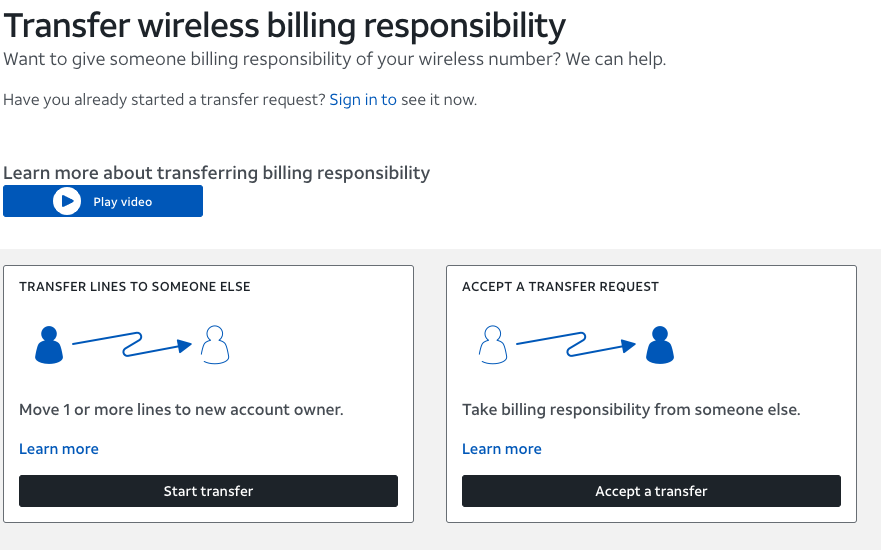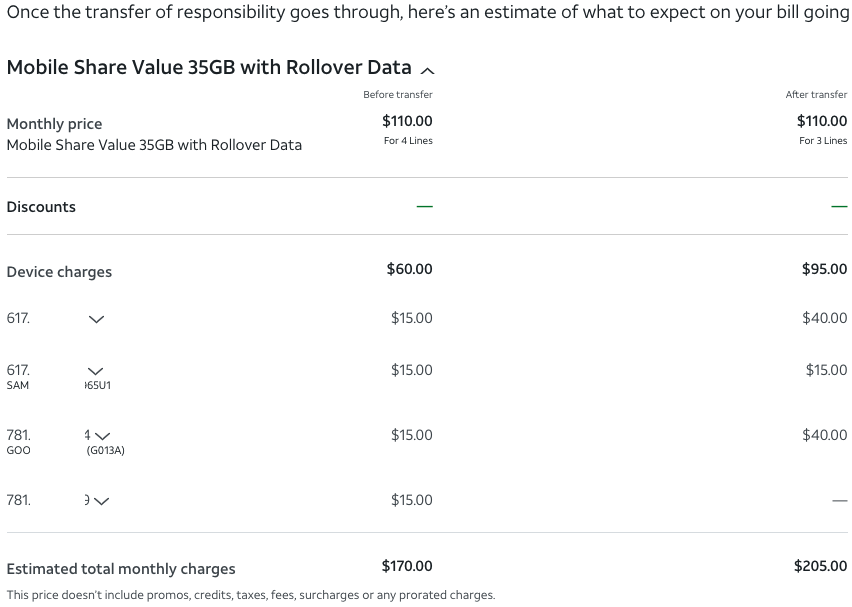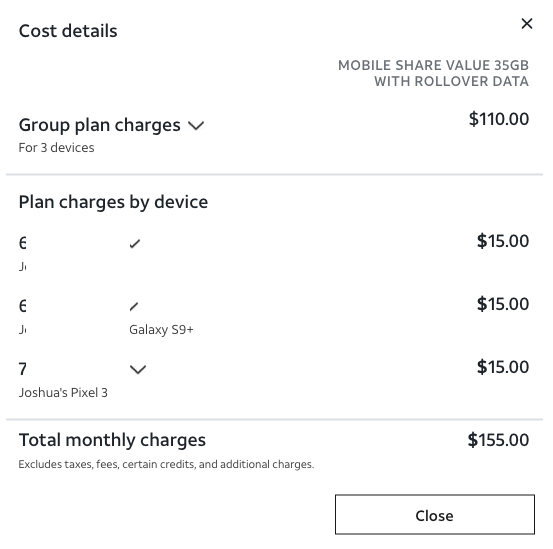Customer experience and trust: an AT&T case study
When I worked closely with Harley Manning and Kerry Bodine, the authors of the customer experience book Outside In, I learned how most customer experience problems are rooted deep within corporate systems. That’s what happened to me this week in an interaction with AT&T.
The odyssey of dropping a line from AT&T
My son, a recent college graduate, has started a job and moved to his own apartment. He’s eager to take charge of his own finances, which includes his mobile phone bill, while keeping the same phone number. (It is some sort of a right of passage when you separate your mobile phone account from Mom and Dad.)
He showed me that there is a a link on the AT&T site to start the process: “Transfer of billing responsibility.”

That looked pretty simple, so I started it.
AT&T helpfully tells you what the bill will look like after you drop a line. Their graphic clearly showed that there would be a $35 a month difference. And I almost missed the startling fact that that would be a $35 per month increase, because that couldn’t be right, could it?

This was a mystery: why, when you drop from four phones to three, does the cost per line rise from $15 per line to $40 per line?
So, of course, I called customer service — after which I was prompted to pick an option for why I was calling. Nothing seemed to make sense, so I picked “billing.”
After a few minute I got on the line with “Ash” who was extremely talkative with a thick Indian accent. He wouldn’t shut up, in fact, despite the fact that he wasn’t saying anything helpful. There is something very frustrating about a customer service rep that talks when he can’t actually help.
Ash eventually transferred me and after five minutes on hold I was talking to “Brian” in the “Transfer of Billing Responsibility Department.” Brian said he’d look into it. He said his computer was being slow. And we waited for the information to show up on his computer for five solid minutes.
Eventually, he told me that there were some discounts that the new graphic didn’t account for, and that most likely I wouldn’t end up paying more after the transfer than before. I pressed him on that — could he guarantee it? He was unwilling to do so. He just said, “Don’t worry about it.”
We have completed the transfer and I just checked the monthly bill information on AT&T’s site. What do you think — am I going to pay more or less now that I have three lines instead of four?
Well, here’s what it says on the site:

It looks like I’m going to save $15 per month. But I’m not very confident in the result.
Customer experience, systems, and trust
Telecom companies consistently end up at the bottom of Forrester’s customer experience rankings. But it’s instructive to look into why AT&T had this problem, and what it means for them.
Why did the original query on their site, using their transfer-of-billing-responsibility tool, show that my bill would go up by $35? Some system within AT&T was incapable of recalculating the bill with the appropriate discounts. If that system had worked properly, I never would have even gotten on the phone with AT&T’s customer service.
Why was “Ash” unable to help? Because the phone response system was unable to recognize that I needed to talk to somebody in the “Transfer of Billing Responsibility” Department. (I still hold him — or whoever trained him — responsible for the fact that he couldn’t help but wouldn’t shut up.)
Why was “Brian” unable to give me the assurances that I needed? Because his own customer service application was unresponsive and he couldn’t get at the information he needed.
In each case, the root cause of the problem was that systems within AT&T functioned in such a way as to undermine customer trust.
And trust is the issue. I’ve been an AT&T mobile customer — with the same phone number — since 1995. That’s 26 years! I’m carrying four lines with them and have been for at least five years. I’ve used their service all over the world. All that information is in their systems somewhere.
At this point, I have no confidence that my bill will end up being what Brian promised it would be, or what the AT&T customer web site says it will be. Nothing that happens now will surprise me. I have no idea what to expect.
I’m thinking it’s time to bolt. And I never would have considered that, if only their systems had functioned in a rational way.
Not terribly surprised. It parallels my customer service experience with AT&T. I bailed from them after they took over Cingular Wireless after one such experience. I dumped their relatively inexpensive Internet service after the contract was up because I had to call them every single month, 24 in total, to get the promised discounts. I dumped DirecTV after AT&T bought them and kept raising my bill while reducing my services. Every time I’ve had to deal with their customer service it’s been a headache. Every. Single. Time.
I have not dealt with any company that was so consistently bad at customer service.
Check out AT&T’s pre-payment plans. Less hassle, fewer gotchas.
I had significant problems with AT&T internet similar to this. Our neighborhood got fiber (wahoo!), so I jumped from Comcast (after 25 years) to AT&T for blazing speeds, especially uploads (which is useful for personal and business). But then it would just stop working. And it was always my fault. Even though we had new lines in the house five years ago. So I ran new lines – removed all excuses – and guess what, bad equipment. They replaced the same equipment five times. Four truck rolls. It took me doing research, pushing them to wire new fiber, and getting the latest modem. That online, it turns out, was reserved for “problem customers.” Nine calls. FOUR truck rolls. And now, it’s fantastic. But think about the cost of those truck rolls, my frustration, not being able to work when it’s down. Crazy. OH – here’s the worst. Two of those truck rolls, some “customer advocate” jerk shows up and tries to sell me their wireless phone service – while my internet is down. That’s crazy. (All in all, now, the service is terrific. But so many industries need to learn from places like Amazon, Gusto, etc.)
I went from AT&T (long-time customer, also went through excruciating agony of splitting now-adult-kid numbers out twice – and yes, you have to keep following up to determine what they said they would do actually got done. I did find the online chat experience far superior to calling them directly, FWIW) to Google Fi, assuming it’d be a better customer experience.
Um, no. Still had same excruciating customer service experiences, followed by no follow-through after I finally canceled service & transferred to T-Mobile to use their 55+ Magenta product.
The jury’s still out on T-Mobile (we only switched in February 2021)…
Betsy, that’s exactly the path I took a few months earlier. So far, so much better. I hope it for you as well.
I just had the same problem trying to split Adult/kids from my plan of 4 phones for 20 years. If I transferred the billing to two phones on the plan they would be treated like new customers and would pay $30 to $40 dollars a month more. I can’t understand why there is no other options to transfer billing.
I feel your pain. There are so few real customer service companies left. The ones I get the best service from are Apple, where an agent actually went away and did research and then called me up the next day with a solution, and, believe it or not, Medicare. Those folks knew what they were talking about were extremely helpful. Verizon, not so much, so be sure to look before you leap from AT&T. 🙂
Long ago, I worked at AT&T Consumer Products, the division that made home phones and answering machines. There, we were taught “You own the problem.” Even if it’s not in your job description, find a solution, or find someone who has the solution.
In that context, I once got a call from a customer with issues connected to her long-distance service. Not my job, but I took her name and number (and gave her mine, as well), spent half a day poking around the massive corporation, and called her back the next day to connect her to someone who could help. And even then, I told her to keep my number, and to call me back if her problem wasn’t resolved.
But that was an entirely different company from the current AT&T, in an entirely different era.
I thought I had just one line with AT&T and had a similar experience when I upgraded by mobile phone and was advised my plan was no longer available, but a comparable plan that would cost me less was. So I followed the steps to change plans and discovered to my distress that the calculated bill was higher than what I had been paying. In my case, I have two iPads which I failed to consider as lines, so I had been receiving a multi-line discount that wasn’t applied to the bottom line. In fact, my bill did go down, but I had the same frustrating experience of having to call AT&T to discover their automatic bill calculator doesn’t apply the credits. My experience was several years ago, so things haven’t improved.
Josh, this is another version of the “calculated misery” model used by airlines. Telecom companies will cut costs everywhere possible until they lose more money than the savings produce. They count on customers being reluctant to switch carriers. By placing the burden of problem solving on the user, they count on us to resign ourselves to substandard results rather than leave. The other option, having us demand better service, is thwarted by slow or ineffective responses, or none at all. When another mobile phone service provider pitched an attractive offer, I gave AT&T—with whom I also had four lines for many years—the opportunity to match or beat it. They weren’t even interested in trying. I left without regrets and encourage you to do the same.
I’ve long ago went with an MVNO.
What is a MVNO? It is cellphone industry speak for a company that resells the main phone companies’ network access.
They are, for the most part, friendlier to deal with, and they tend to be much cheaper. The big companies are not worth the premium.
The one I use will even automatically pass on savings over time. The big cell companies hope you never check their latest offerings and ask for a price adjustment.
On the other hand, forget all this – if everyone switched over to MVNOs, the advantages would disappear.
Wish cable companies had this kind of arrangement.